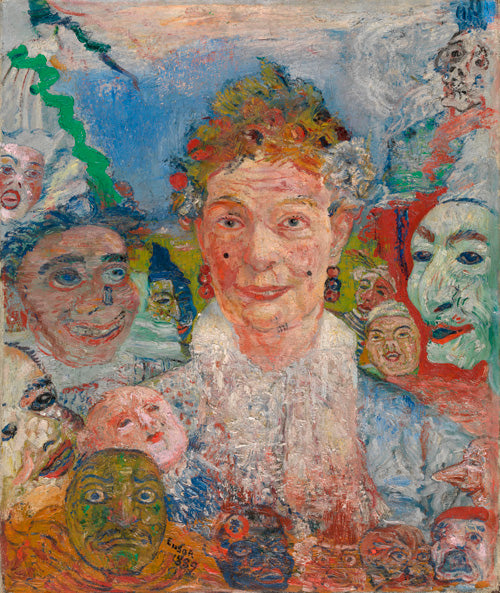Description
The work "Elder with masks (mascara theater)" by James Desor, painted in 1889, is located in the context of symbolism, an artistic movement that sought to express emotions and ideas through shapes and colors, as opposed to the realism that predominated At the time. In this painting, Ensor explores the theme of duality between life and death, theater and reality, an aspect that is recurrent in his work.
He painting It presents an intriguing composition focused on an old woman, whose figure seems to be both a protagonist and a spectator of the world of masks that surround her. The old woman, located in the center of the composition, is represented with a face that radiates wisdom and experience. His look, direct and penetrating, seems to challenge the viewer, inviting him to immerse himself in the complexity of the theatrical context it represents. This use of the central figure can be interpreted as a self -referential figure that questions the nature of art and perception.
The color plays a fundamental role in the sour work. The vibrant and contrast rich palette, which includes warm and cold tones, creates a feeling of dynamism, which is reflected in the masks of striking colors that adorn the background. These masks, which are the essence of the "theater" mentioned in the title, seem to come alive, dance around the central figure and add a sense of holiday and at the same time of restlessness. The exaggerated characteristics of the masks underline the artificiality of reality, an issue that Desor continually questioned in their work. The way in which masks occupy the space of painting can be interpreted as a criticism of social hypocrisy and the superficiality of human behavior.
In relation to the technique, Desor uses a loose and expressive approach that allows fluid interaction between the elements of the work. The brushstroke is visible and vigorous, highlighting its distinctive style that moves away from academicism. His ability to mix influences of impressionism and postimpressionism is evident, although always with a personal seal that differentiates him from his contemporaries.
The theme of the masks has a particular resonance in the European culture of the late nineteenth century, especially in the context of the Carnival, where the liberation of social norms through representation was celebrated. Ensor, with your critical gaze, uses this festive connotation to deepen the nature of identity and public perception, making "old man with masks" not only a visually shocking work, but also a deep social comment.
In summary, James Ensor achieves in "old woman with masks" to create a rich and complex visual universe that causes a reflection on the life, death and role of theater in society. The old woman, surrounded by masks that seem to come alive, becomes a symbol of the struggle between authenticity and falsehood, inviting the viewer to question their own perceptions and the nature of reality itself. This work, emblematic of his style, is aligned with the search for symbolism for expressing the ineffable through the visual, and positions to reor as a pioneer in the exploration of the tensions between the individual and his theater environment.
KUADROS ©, a famous paint on your wall.
Hand-made oil painting reproductions, with the quality of professional artists and the distinctive seal of KUADROS ©.
Art reproduction service with satisfaction guarantee. If you are not completely satisfied with the replica of your painting, we refund your money 100%.

